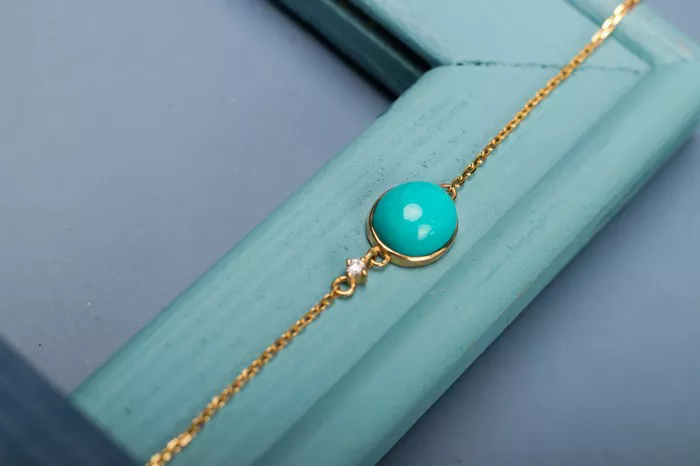Turquoise is a timeless gemstone prized for its vibrant blue-green color and cultural significance. From ancient civilizations to modern jewelry designers, turquoise has remained a beloved stone for its beauty and versatility. However, the question remains: Is turquoise stone expensive? In this article, we’ll explore the factors that influence the price of turquoise and examine whether it is considered a costly gemstone.
Introduction to Turquoise
Turquoise is a hydrated phosphate mineral that belongs to the family of copper minerals. Its distinctive blue-green color is due to the presence of copper ions within its chemical structure, along with varying amounts of iron and aluminum. Turquoise can range in color from pale sky blue to deep green-blue, with some stones exhibiting matrix patterns or veining caused by the presence of other minerals.
Throughout history, turquoise has been revered by cultures around the world for its beauty and spiritual significance. Ancient civilizations such as the Egyptians, Persians, and Native Americans adorned themselves with turquoise jewelry and used it in religious ceremonies and protective amulets. Today, turquoise remains a popular gemstone in jewelry design, fashion, and art.
Factors Influencing the Price of Turquoise
Several factors influence the price of turquoise, including its color, clarity, hardness, size, and origin. Let’s explore each of these factors in more detail:
Color: The most critical factor in determining the value of turquoise is its color. Vivid, saturated shades of blue or green with minimal matrix are highly prized and command higher prices. Stones with a uniform color and intense hue are considered more valuable than those with uneven color distribution or visible matrix patterns. Exceptional turquoise may exhibit a rare and sought-after robin’s egg blue or Persian blue color.
Clarity: Turquoise is known for its opaque or semi-translucent appearance, often with matrix patterns or veining. While some matrix can enhance the beauty and character of turquoise, stones with minimal matrix and consistent coloration are generally more valuable. High-quality turquoise should exhibit good translucency and uniformity of color throughout the stone.
Hardness: Turquoise has a moderate hardness ranging from 5 to 6 on the Mohs scale, making it relatively durable but still susceptible to scratching and chipping. Stones with excellent polish and surface finish are more desirable and may command higher prices due to their enhanced durability and longevity.
Size: As with other gemstones, the size of turquoise can significantly impact its price. Larger stones are rarer and thus more valuable than smaller ones, especially if they exhibit high-quality color, clarity, and matrix patterns. However, the price per carat tends to decrease as the size of the turquoise increases, meaning that larger stones may offer better value for money on a per-carat basis.
Origin: The geographic origin of turquoise can also influence its value and desirability. Turquoise from certain locations, such as the Sleeping Beauty mine in Arizona or the Persian mines in Iran, is highly prized for its exceptional color, clarity, and historical significance. Stones from renowned mines with a provenance of quality may command premium prices in the market.
Is Turquoise Stone Expensive?
Given the factors that influence the price of turquoise, it’s clear that this gemstone can range in price from relatively affordable to moderately expensive. Turquoise with exceptional color, clarity, size, and origin can command high prices in the gemstone market, particularly for top-quality stones with minimal matrix and intense hues.
However, turquoise is also available in a range of qualities and price points to suit various budgets and preferences. Smaller turquoise cabochons or beads with more common colors and matrix patterns may be more affordable for those seeking turquoise jewelry without breaking the bank.
In recent years, the price of turquoise has been influenced by factors such as supply and demand dynamics, economic conditions, and fluctuations in the gemstone market. While turquoise prices have historically shown steady growth, occasional fluctuations may occur due to external factors such as changes in mining regulations or geopolitical events.
Ultimately, whether turquoise stone is considered expensive depends on individual perspectives and priorities. For some, the rarity, beauty, and cultural significance of turquoise justify its higher price tag, while others may prefer more affordable alternatives or prioritize other factors when choosing a gemstone.
Conclusion
In conclusion, turquoise is a beloved gemstone prized for its vibrant blue-green color, cultural significance, and historical legacy. While turquoise can range in price from relatively affordable to moderately expensive, its value is influenced by factors such as color, clarity, hardness, size, and origin. Whether turquoise stone is considered expensive depends on individual preferences, budgetary constraints, and market conditions. Regardless of price, turquoise continues to captivate gemstone enthusiasts worldwide with its timeless beauty and enduring allure.


